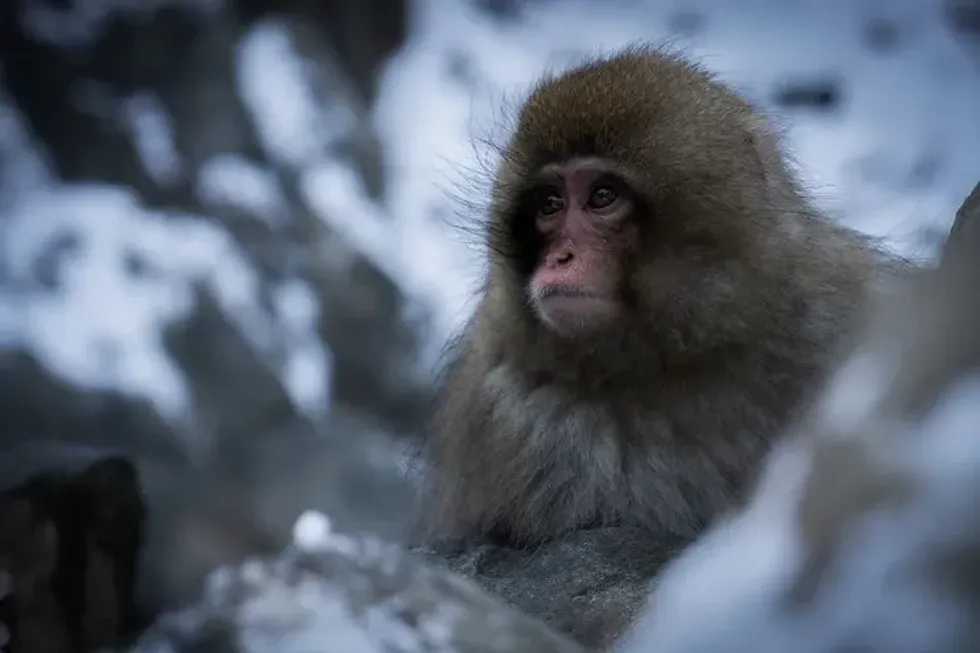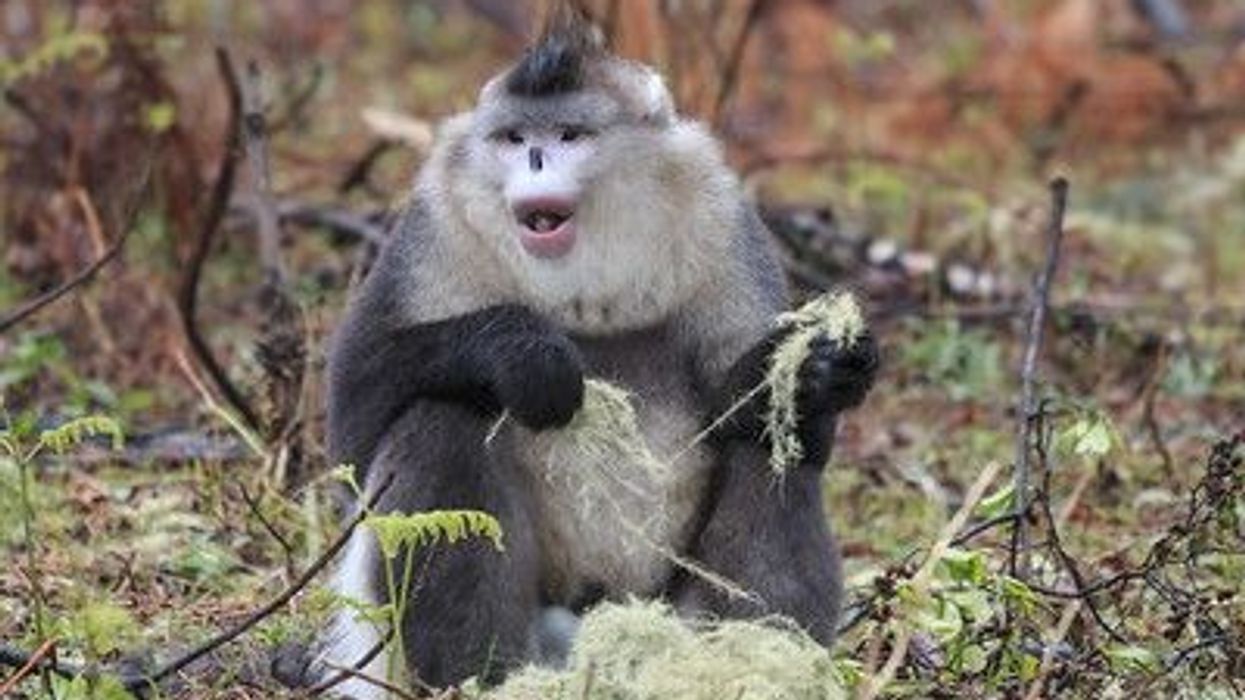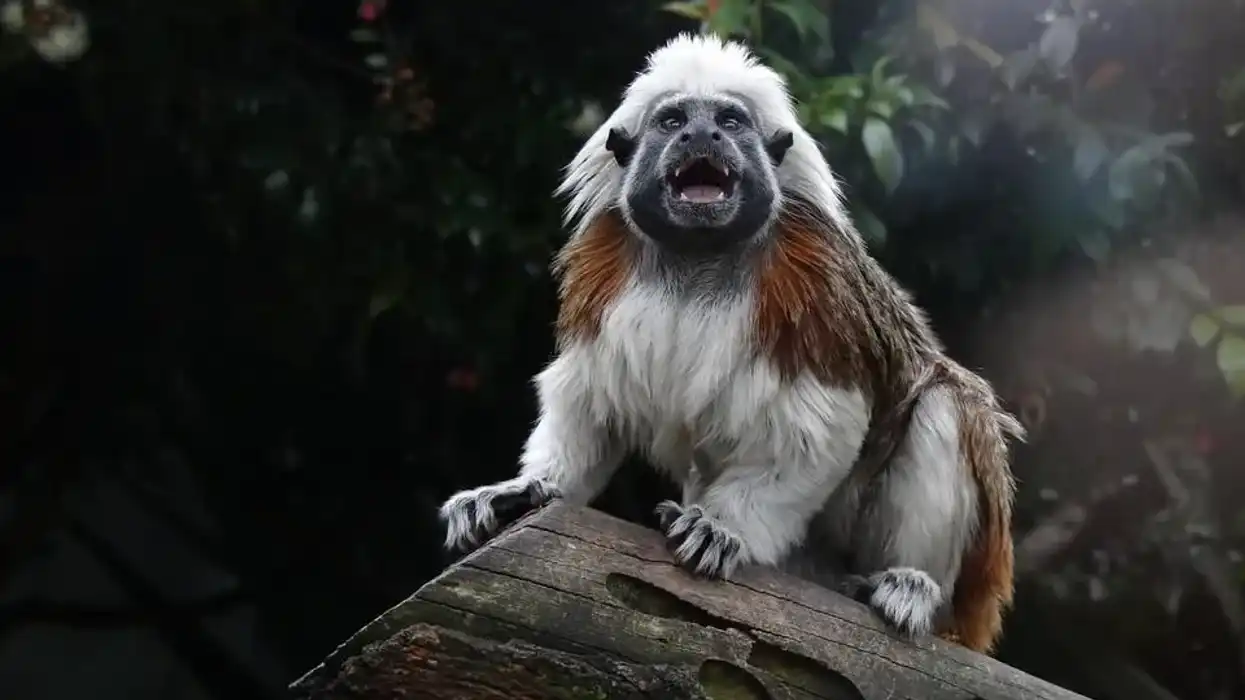The Japanese macaque (Macaca fuscata) or commonly known as the snow monkeys are Japanese animals found throughout the country. They are omnivorous in nature and usually prefer living in colder climates.
Japanese macaque (Macaca fuscata) have a thick coat of fur which protects them from extreme cold weather.
There is also an interrelationship between the location of the Japanese macaques and their body weight.
The snow monkeys found in the southern parts of Japan have less body weight as compared to the ones found in the northernmost regions. The Japanese macaque (Macaca Fuscata) usually give birth to only one offspring at a time and the cheeks of the females get redder due to hormonal changes in their body, which attracts the alpha males.
A lot of characteristics of the Japanese snow monkeys are similar to that of a homosapien, like enjoying in hot springs, grooming their partners to strengthen relationships, snowball fights. Research also suggests that some of the viruses found in the human body can also be found in Japanese macaques.
The predators of the Japanese macaques are humans, Japanese Wolves, Hawk Eagles, Feral Dogs.
The body of a Japanese macaque is covered with thick fur which acts as a protective shield against chilly temperatures in the northernmost areas of Japan. The snow monkeys are the only non-human primates that can survive in such extreme weather conditions.
The fur of the snow monkey usually has brown and grey shades. Subtle tones of orange and white can also be seen in older monkeys. After reading these interesting facts about the Japanese white monkey, do check out more such information on masked palm civet and mangabey.
Japanese Macaque Interesting Facts
What type of animal is a Japanese macaque?
The Japanese macaque is a monkey and the scientific name for this specific type of species is Macaca fuscata. The snow monkeys, as the name suggests are snow lovers and are natives of Japan, in the north where there is high snowfall during the winter period.
This species of monkey can usually be found on snow-capped mountains or tree-tops and forests where there is plenty of flora and fauna for consumption.
What class of animal does a Japanese macaque belong to?
The Japanese macaque belongs to the class of mammalia. The females give birth to a single young monkey on completion of the gestation period.
They are usually found in the wild near a hot spring where the temperatures are a bit warm. Their mating season can extend over a period of four to five months. During the mating season, females have multiple partners.
How many Japanese macaques are there in the world?
The Japanese macaque have a good population and are not endangered. Due to their high numbers, they can also adapt to different environments and sustain themselves.
The species of the Japanese Macaques would not be extinct for many years to come, as they can easily adapt to both cold and warm climates. An additional fact is that they are omnivores, so they could basically eat anything to survive. They move around as a part of a troop, for better protection against predators.
Where does a Japanese macaque live?
The Japanese macaque is well-adapted to locations that are extremely cold.
The snow monkeys can be found on mountains covered in snow, on top of the trees as well as on the ground, broadleaf forests, warm temperate forests, deciduous and evergreen forests. The male snow monkeys usually like spending their time on the ground while the adult females can usually be spotted on the top of the trees.
But, both the females and the male Japanese macaques love to relax in the hot springs during temperatures dropping as low as -10 to -20 degrees (°C).
What is a Japanese macaque's habitat?
The Japanese macaques live in the northernmost Highlands of Japan, mainly covered with deciduous, evergreen, tropical, and subtropical forests, and usually found on trees and mountains. Cold weather, where there is high snowfall in January and December, is the perfect habitat for snow monkeys.
Who do Japanese macaques live with?
The Japanese macaques live with their own troops. When an adult snow monkey is ready to give birth to an offspring it usually finds a secluded place and centers its attention towards the care and nurture of the offspring. But if the troop is moving, the female doesn't leave her troop behind.
How long does a Japanese macaque live?
On average, the Japanese macaques may live for 28-32 years. But, many factors like low immunity, any infection in the body, or other external factors may affect the lifespan of the snow monkey. The Japanese macaques can sustain in any extreme weather conditions, which is an added benefit.
How do they reproduce?
The female Japanese macaques reach sexual maturity almost a year earlier as compared to the male Japanese macaques. The female chooses her alpha male according to his rank.
After spending enough time with her mate and the completion of a period of six months of gestation, the female Japanese macaque gives birth to an offspring. Usually, in some groups, the male monkeys do not tend to the infants, but older Japanese Macaques, feed, groom, clean, and protect the baby snow monkey just like their mothers.
What is their conservation status?
The conservation status of Japanese macaques is of Least Concern. This suggests that the overall population of the snow monkeys is high and continues to increase with every passing year.
Japanese Macaque Fun facts
What do Japanese macaques look like?
These Japanese monkeys have a stocky body along with reddish face which is very similar to that of the humans. Most often the color of the coat of a Japanese monkey is grey or brown which grows thicker during winter, allowing these snow monkeys to stay warm.
Also, the adult Japanese macaque is sexually dimorphic and likes spending most of its time on the ground while the female adults, along with their offspring, spend time relaxing on the trees.
How cute are they?
The adult Japanese macaques may not look so adorable with their full-grown body, but infants are very cute and adorable in appearance. The infants usually have dark brown hair when they are born and a pinkish face, unlike the adult Macaca fuscatas.
The Japanese macaques, while dipping in the hot springs or huddling together during cold weather, look extremely delightful and cute.
How do they communicate?
The Japanese macaques communicate with each other using different sounds, signals, and also physical touch. During the mating season, the female Japanese macaque attracts the alpha male of higher rank by walking backwards towards her potential mate, looking back at the partner over her shoulder, and also by squeaking and squealing using particular vocals.
How big is a Japanese macaque?
The Japanese macaque is 20.60 in to 22.44 in tall. The male snow monkeys are usually taller than the female Japanese Macaca fuscata.
There is a connecting link between the bodyweight of the Japanese macaque and the climate in which it is located. The snow monkeys habituated in the northernmost parts have a bigger body, versus primates found in the southern region, with a smaller body. The adult male Japanese macaque is sexually dimorphic in nature.
How fast can a Japanese macaque run?
The Japanese macaque can run at an average speed. Even though snow monkeys are medium-paced runners, they have excellent locomotive movements that help them leap for huge distances. The Japanese macaques also are great swimmers, which also allow them to hunt for food in deep waters.
How much does a Japanese macaque weigh?
The average weight of a Japanese macaque would range from 8-11 kg. But research suggests that the Japanese macaques found in the southern areas of Japan have less body weight as compared to the snow monkeys found in the northernmost regions which have high snowfall and are usually colder.
What are their male and female names of the species?
Both the male and female species of Japanese monkeys are called Japanese macaques. There are no specific scientific names for the two sexes of snow monkeys.
What would you call a baby Japanese macaque?
There is no particular name for a baby Japanese macaque. Like all other monkeys, the newborn Japanese macaque offspring is called an infant.
What do they eat?
The diet of a Japanese macaque consists of leaves, seeds, insects, small animals. The Japanese Macaques also eat nectar-filled flowers, roots, cereals, tree bark, fungus, ferns, and even soil.
They are omnivorous in nature, but most of their diet consists of mature plants and flowers, which are easily accessible. The Japanese macaques are opportunistic omnivores which means that they usually consume flora. Insects, which they remove from their bodies during the grooming process, are also a part of their diet.
Are they loud?
No, snow monkeys are not loud in the wild. But they have calls and squeals loud enough to cause a nuisance. The snow monkeys usually cause noise together when they sense danger and want to alert other members of their troop. But, typically, Japanese macaques are less noisy.
Would they make a good pet?
No primate species are considered good pets as they do not have an environment where they can grow and develop. The Japanese macaques cannot be kept as pets because they wouldn't reach their development degree under restrictive habitats.
Did you know...
Japan macaques have cheek pouches for the storage of food.
Why do Japanese macaques have red faces?
Japanese macaques have red faces to attract mates for reproduction during the mating season. The redness also occurs in the alpha male when they are sexually mature. But the red pigmentation in female Macaca fuscata occurs because of a change in hormones in the body.
Do Japanese macaques have snowball fights?
Young Japanese macaques love to play in the snow and indulge in snowball fights, and adult snow monkeys usually enjoy relaxing in hot springs.
Here at Kidadl, we have carefully created lots of interesting family-friendly animal facts for everyone to discover! Learn more about some other mammals including patas monkey, or woolly monkey.
You can even occupy yourself at home by drawing one on our monkey coloring pages.









